“Phonological awareness,” “phonemic awareness,” and “phonics,” are literacy terms we often hear used simultaneously, and maybe even interchangeably! However, as we work with children, helping them to develop a strong foundation of literacy and language skills, we must realize the important distinction between these terms.
What is Phonemic Awareness?
Phonological Awareness is the ability to hear and manipulate parts of spoken language. Skills are at a listening/auditory and spoken/verbal, level – NO print – spoken words requiring ears only!
It is a broad term and comprised of a group of skills that progress developmentally, but of course, overlap as children mature. As phonological awareness skills develop, children will begin to attend to, discriminate, remember, and manipulate (segment/blend) words and sounds at these levels or chunks:
- Sentence
- Understanding that the sentence they hear, “Thecatisfat” is comprised of four separate words “The cat is fat”.
- Word
- Understanding the words “cat” and “fat” rhyme.
- Understanding two words become one in a compound word: cat + fish = catfish
- Syllable
- Understanding the word “cat” as one syllable.
- Phonemic Awareness
- Understanding and manipulating the three sounds in “cat” = /k/ /a/ /t/
Let’s take a closer look at phonemic awareness. It is a specific skill under the broad category of phonological awareness. If we put phonological awareness skills on a continuum, phonemic awareness is the most sophisticated and last to develop.
The following is a list of specific phonemic awareness skills. Keep in mind, all of these are done at the auditory/spoken level, NO print:
- Recognize words in a set begin with the same sound (cat, cake, kite all begin with the /k/ sound)
- Isolate and say the first/last/middle sound/s in a word (cat begins with the /k/ sound and ends with the /t/ sound, etc.)
- Blend separate sounds (phonemes) into words (/k/- /a/ - /t/ = cat)
- Segment words into sounds (cat = /k/- /a/ - /t/)
- Delete/manipulate sounds in spoken words (What is "cat" without the /k/? - "at"
Basically, phonemic awareness skills include learning how to break apart (segment) and combine (blend) the sounds in words. Phonemic awareness should begin in Pre-K with the focus on the simpler phonemic awareness skills of isolation and identifying beginning and ending sounds. Because phonemic awareness is a more advanced phonological awareness skill, development continues into kindergarten and early elementary.
Why are phonemic awareness skills so important?
Well, children who cannot hear and manipulate the phonemes of spoken words will have a very challenging time learning how to relate phonemes to letters when they see them in written words, Phonics. Therefore, Phonological Awareness skills are foundational for Phonics.
What is Phonics?
Phonemic awareness, however, is not phonics.
Phonics skill development focuses on helping children understand the relationship between sounds of written letters, letter combinations, and words. Phonics deals with written language, therefore we need to use our ears AND eyes, where as Phonological Awareness (and phonemic awareness) involves NO print, just listening and saying sounds and words. To keep this straight in my mind, I think about phonological awareness activities as those which can be completed with the eyes closed, while phonics activities require us to see the written letters and words, so, eyes need to be open.
Both phonemic awareness and phonics are interrelated, foundational skills and necessary for reading. However, it is important to understand a foundation of all phonological awareness skills should built before intense concentration is given to phonics.
The Benefits of Phonemic & Phonological Awareness
PreK is the time to begin to lay the foundation for strong reading skills, and it is important to begin by concentrating on phonological awareness skill development. In addition, if we do not help children gain the foundational understanding of sounds that phonemic awareness brings, phonics (assigning a letter a sound, spelling, and reading) will make little sense. And research supports this.
- “Phonological Awareness is critical for learning to read any alphabetic writing system.” Moats, L, & Tolman, C (2009). Excerpted from Language Essentials for Teachers of Reading and Spelling (LETRS): The Speech Sounds of English: Phonetics, Phonology, and Phoneme Awareness (Module 2). Boston: Sopris West.
- It is also found that phonemic awareness is the foundation for spelling and word recognition skills. “Phonemic awareness is one of the best predictors of how well children will learn to read in the first two years of school instruction.” Reading Rockets/WETA.
In summary, Phonemic Awareness is critical for reading. It primes readers for mapping speech to print, connecting sounds with written symbols, and also gives children a way to approach sounding out, blending sounds to make and read new words.
Phonological Awareness Activities & Strategies
In Pre-K, Phonological Awareness skills most certainly need to be taught explicitly, but fun extra practice can be woven in anytime.
Activity 1: Games to Play While Lined Up
Here are a few ideas for some simple games to play while children wait in line:
- Sentence game: say a sentence, “The cat is fat”. Tap the first 4 children on the head as you say each word of the sentence. Ask, “How many words?”, four! Repeat the sentence, or say a different sentence, as you go down the line of children.
- Rhyme game: Say a few words that rhyme, “cat, fat, bat”. Prompt children to join in the game. You may need to prompt by saying some initial sounds: /p/ - at, /s/ - at, etc. Include silly words (/z/ - at) and blends (/th/ - at)!
- My Turn/Your Turn syllable count game: (My Turn) Model clapping/stomping/tapping the syllables for objects you see in the classroom (Ceil-ing, floor, ta-ble, com-pu-ter). (Your Turn) Prompt children to imitate you. Ask after each word, “How many syllables?”
- Repeat the beginning sound game: /c/ - /c/ - cat, /c/ - /c/ - cake, /c/ - /c/ - car. Prompt children to join in with other words.
The Get Set for School curriculum offers many activities that support early Language and Literacy skill development for children in your Early Childhood classrooms.
Here are some additional sample activities and products to explicitly instruct young learners in some key Phonological Awareness skills.
Activity 2: Discriminate rhymes
Each of the four Mat Man books features the beloved character, Mat Man. Rhyming verses in all the books help children discriminate and learn about rhymes.
Mat Man helps students learn about shapes, professions, rhymes, while expanding their imaginations, exploration, and community awareness.
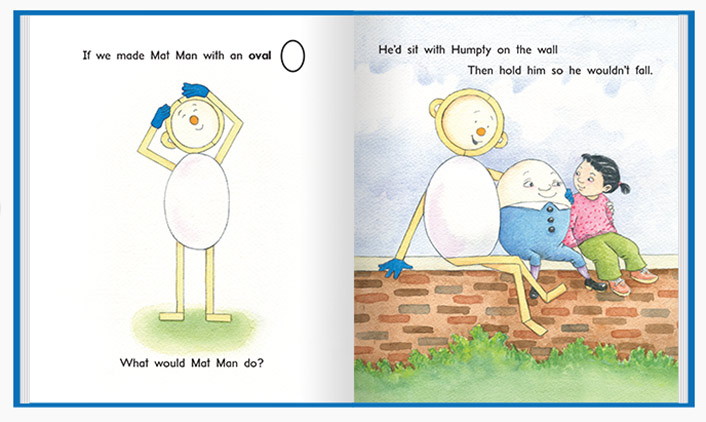
Click here to see more sample pages from the Mat Man Book Series.
Activity 3: Discriminate between environmental sounds and speech sounds
Children learn important social, math, literacy & language concepts as they move and sing to upbeat songs on the Sing, Sound, and Count with Me Music Album
For example, the song “Syllable Sound Off” helps to develop children’s understanding of syllables as they listen for and move to identify 2, 3 and 4 syllable words… all in one song!
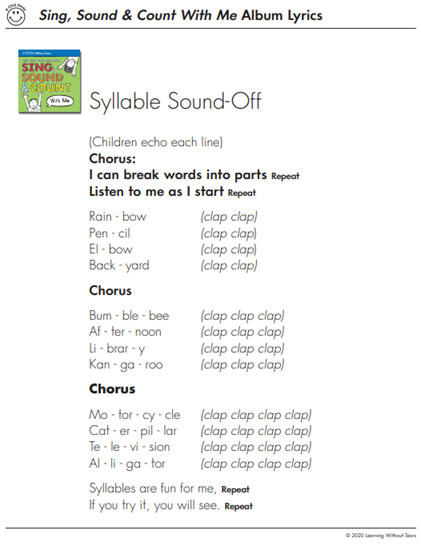
Rhymes are taught in a fun playful way in the song “Rhyming Riddles”. In fact, most songs on the music album include verses with rhyming words!
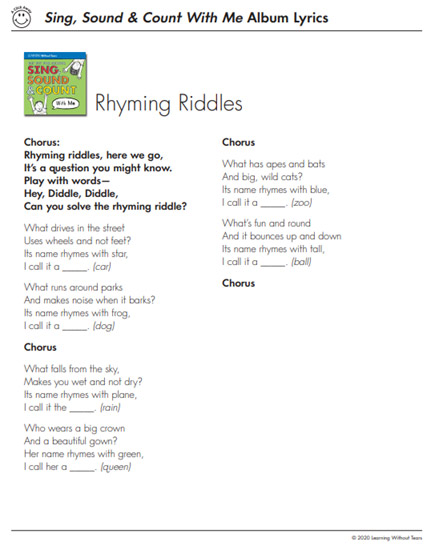
Activity 4: Identify Sounds and their sources
The Sound Around Box is a versatile classroom tool that will help you teach early language and literacy concepts in a fun and hands-on way. It provides the opportunity for many group activities which will help children develop important social skills as they engage in multisensory play with rhymes, syllables, beginning sounds, alphabet knowledge, letters, word parts, and test their memory skills!
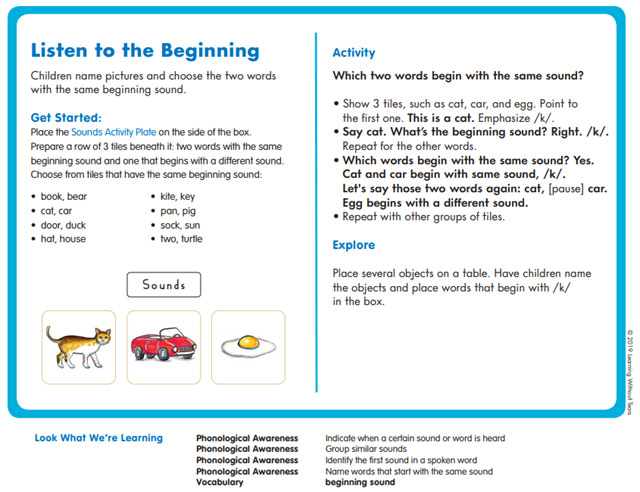
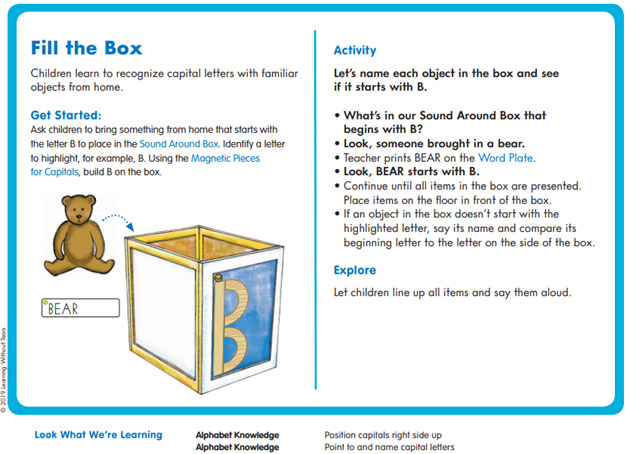
Activity 5: Develop early language, literacy, motor, and social skills
Line It Up engages children in fun interactive activities that develop early language, literacy, motor, and social skills. The set includes a mountable magnetic display bar to hold the Story, Letter, and Coloring Cards.
The 26 Coloring Cards each have simple picture. The picture can be colored, but also used to facilitate a “Syllable Chant” activity. For example, on the “A” card: al-li-ga-tor.
The 26 Picture Cards can be used for phonemic awareness activities as children name each picture and identify those that begin with the target sound. For example:
- Show picture side of Letter Card A. Name each picture.
- Alligator begins with /ă/. Say it with me, /ă/, alligator.
- Does violin begin with /ă/? No, violin begins with /v/.
- Does astronaut begin with /ă/? Yes, /ă/, astronaut.
- Continue with banana and apple.
- Let children circle beginning /ă/ pictures.
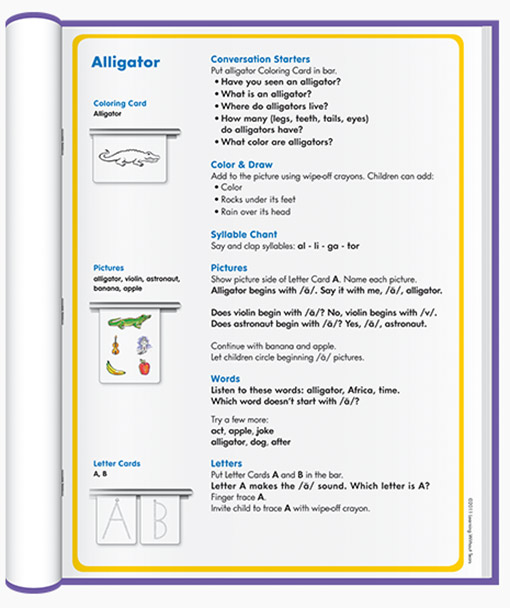
All of the Get Set for School products support a variety of learning opportunities for your developing children. The products and activities highlighted shown here are just a snapshot of the many skills these products can facilitate.
To learn more about these and other Get Set for School activities and products, visit our website.
A—Z for Mat Man and Me
Seamlessly bring the ABCs to life while building foundational literacy skills with our new letter book series. Each of our illustrated letter books introduces a letter of the alphabet and emphasizes their associated sound through captivating, visual stories. The engaging stories in each book capture children's imaginations and expose them to social-emotional skills and diverse cultures.
You can Learn More → .